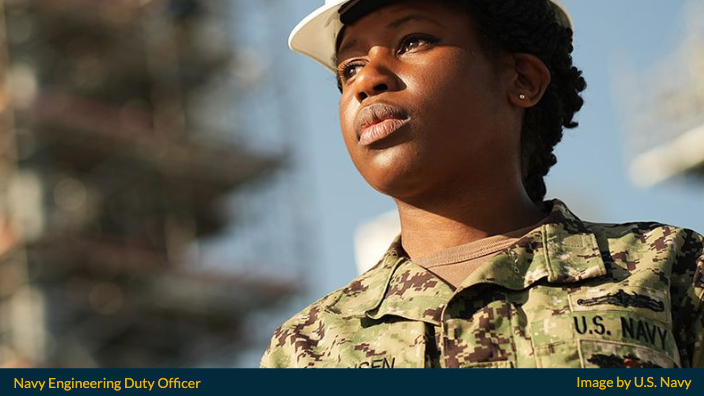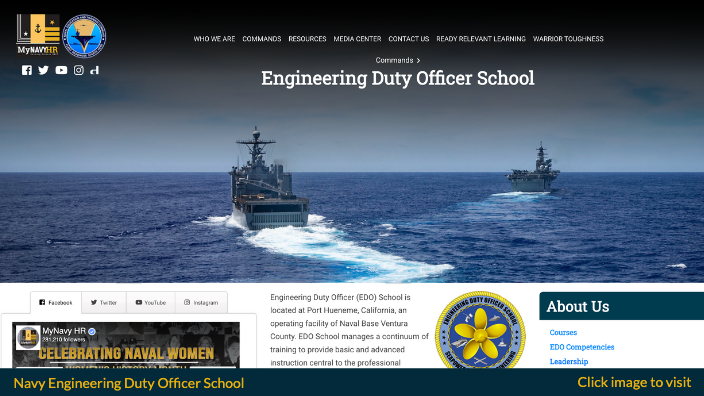Last Updated on March 5, 2024
This guide provides information that will help you with your decision to become a Navy Engineering Duty Officer during Fiscal Year 2024.
The Engineering Duty Community is tasked with overseeing and guiding the engineering aspects and operational management involved in the lifecycle of naval vessels and their onboard systems.
This includes the inception, development, procurement, construction, upkeep, updates, modifications, refurbishments, and eventual decommissioning of ships and submarines.
The primary objective of this community is to ensure the ongoing combat effectiveness of the naval fleet and to spearhead efforts in developing and integrating future maritime capabilities.
Let us start with basic definitions, then we shall move on into more specifics.
What is an Engineering Duty Officer?

Engineering Duty Officers (EDOs) are Restricted Line Officers in the Navy who are combat-ready and technically educated, having completed Engineering Master’s Degree and/or Doctoral studies at the Naval Postgraduate School (NPS) or the Massachusetts Institute of Technology (MIT).
EDOs become Department of Defense Acquisition Workforce members and are admitted as Department of the Navy Acquisition Professional Members.
What Does An Engineering Duty Officer Do?
Navy Engineering Duty Officers guarantee that the Navy and Joint Forces of the United States operate and battle with the most capable vessels, systems, and equipment feasible.
Their math, scientific, and business management skills will be critical to the Navy’s continuous improvement of warfighting capabilities and the maintenance of a secure cybersecurity network.
Among the job duties that may be assigned to EDOs are the following:
- Conducting research on critical operational requirements
- Overseeing the integration of weapons and electrical systems into new ships, as well as designing new ships and their systems.
- Supervise the development, testing, purchasing, and certification of salvage, towing, pollution mitigation, and diving life support systems.
- Creating, engineering, and maintaining sophisticated and integrated space and weapon systems
- Managing the Navy’s fleet’s construction, delivery, maintenance, conversion, and overhaul
- Conducting dive and salvage operations, which may include search and recovery, submarine rescue, underwater ship maintenance, and experimental diving research.
- Fleet salvage and diving operations, deep sea search and recovery operations, and major undersea ship, submarine, and aircraft carrier repairs are all part of this job.
Navy Engineering Duty Officer Duty Stations
The Navy Engineering Duty Officer profession is highly regarded and may take officers practically everywhere.
The majority of EDOs are assigned to shore commands, such as:
- Washington, DC
- San Diego, CA
- Norfolk, VA
- Bremerton, WA
- Pearl Harbor, HI
But there are also fascinating sea and shore tours available throughout the world, such as:
- Australia
- Singapore
- Italy
- Spain
- Canada
- Japan
- Saudi Arabia
- Bahrain
How to Become an Engineering Duty Officer
The Engineering Duty Officer Community does not have direct access to commissioning sources such as the Naval Academy (USNA), Officer Candidate School (OCS), or Naval Reserve Officers Training Corps (NROTC).
The EDO community obtains accessions from the Unrestricted Line communities, specifically the Surface Warfare community.
A typical new EDO is knowledgeable about combat, a high performer, and academically competent to earn a technical master’s degree.
Ways to become an EDO
Lateral Transfer
In February and August of each year, the Lateral Transfer/Redesignation boards convene.
For more information on how to do this, look at MILPERSMAN 1212-010 or contact the EDO Community Manager.
EDO Commissioning Option
The ED Option is accessible to candidates selected through USNA, NROTC, OCS, Seaman-to-Admiral 21, and the Merchant Marine Reserve during Service Selection.
MILPERSMAN 1212-040 contains the details of the EDO Option Program.
a) SWO EDO Option
To acquire their SWO pin, they must complete a SWO EDO Option. Within six months of becoming a Lieutenant, the SWO EDO Option’s designator code will be changed to 1460.
SWO ED Option holders who choose to stay in the Surface Warfare Community must submit a command-endorsed request letter to the Engineering Duty Officer Community Manager (OCM) via the Surface Warfare Officer Community Manager requesting to refuse the EDO Option and continue in the URL community.
Approval of the request to not take the EDO Option must be given by both the EDO and SWO Community Managers.
b) Submarine EDO Option
A Submarine EDO Option is required for Submarine Officers to complete their Division Officer and Department Head tours.
Submarine EDO Options must enroll in graduate school at the Naval Postgraduate School in order to receive a technical Master’s degree.
Also, Submarine EDO Options are welcome to attend MIT but must contact the Junior EDO Detailer to inquire about quota availability.
If they don’t go to graduate school after their Division Officer tour, they won’t be able to use their EDO Option.
To execute their option, submarine EDO Options must submit a command-endorsed ED Option Execution letter to BUPERS-314C (EDO Community Manager) with a copy to PERS-42 (Submarine Distribution Division).
Navy Engineering Duty Officer Requirements
Surface Warfare Engineering Duty Officer
The following basic requirements to become a SWO (EDO option) are current as of December 2023, per the Navy Personnel Command. No updates have been issued so far.
Citizenship
SWO EDO option applicants must be citizens of the United States.
Age
Candidates are required to be a minimum of 22 years old and must receive their commission prior to reaching the age of 54.
Education
Candidates are required to hold a Bachelor of Science degree in specified disciplines, including naval architecture and various branches of engineering such as mechanical, electrical, industrial, aerospace, civil, chemical, ocean, marine, materials, and environmental engineering.
Degrees in physics, chemistry, computer science, metallurgical science, ceramics, polymer science and engineering, mathematics, operations research, and systems engineering are also acceptable, though systems engineering degrees may necessitate a detailed review of the curriculum by the relevant naval authority.
Degrees in engineering technology and engineering management are not considered suitable for this role. However, the Officer Community Manager for Engineering Duty (ED OCM) may approve other degrees if the curriculum’s content and rigor align with the accepted fields of study.
In addition to a bachelor’s degree, an advanced technical degree, such as a Master of Science or a Doctorate in one of the approved fields, is required.
A Master of Business Administration may be considered as an alternative to an advanced technical degree, but this requires a waiver to be submitted and approved.
At the level of a lieutenant (O-3), a professional engineering license might suffice in place of an advanced technical degree.
There are provisions for flexibility under exceptional circumstances, such as significant experience in a critical area of need, where the educational prerequisites may be adjusted or waived.
In such cases, applicants must provide detailed justification for the exemption.
Physical
Selectees shall maintain eligibility for sea duty and worldwide assignment in accordance with Chapter 15 of the Medical Department’s Manual.
Physical fitness requirements must be met by candidates when they apply and when they are commissioned.
Candidates must meet the weight and body fat percentage requirements.
Technical Skills and Abilities
Candidates are expected to have a solid background with at least 5 years of relevant experience in fields such as naval engineering, naval architecture, systems engineering, mechanical engineering, nuclear engineering, or other related engineering disciplines.
Practical involvement with ships and/or ship systems, regardless of the specific job title, will be taken into consideration. Additionally, experience in acquisition, particularly in areas like production quality management, manufacturing, engineering, test and evaluation, and program management, is highly valued.
For individuals coming from civilian sectors, professional experience must be substantiated through a detailed curriculum vitae accompanied by at least three professional references.
For those with a military background, verification of experience requires the submission of the applicant’s service record, encompassing all performance evaluations, held positions, and completed military training or education.
The availability of specific roles and opportunities will mirror the current needs and demands within the field. The determination of these areas of need and the allocation of positions will be overseen by the relevant naval authorities, with input from both the Engineering Duty Officer Community Manager (ED OCM) and higher command structures.
Security Clearance
Applicants are required to complete a Personnel Security Questionnaire, using Standard Form 86 (SF 86), and must qualify for a Secret-level security clearance.
Waivers
There may be times when an application doesn’t meet all of the requirements but still has a great record or the skills the Navy needs. In these cases, a waiver may be given.
Who May Apply
The sources for accession into the program include:
a. Civilians who meet the necessary qualifications and requirements.
b. Selected Reservists (SELRES). Officers from the SELRES who are accepted for lateral entry into active duty are required to resign from their reserve commission and accept a commission for active duty service.
Upon Commissioning
All officers newly appointed will undergo Officer Development School (ODS) in Newport, Rhode Island. Further specialized training and orientation will be tailored by the Commander of Naval Sea Systems Command (COMNAVSEA) based on the specific role and rank to which the officer is assigned.
There is a provision for waiving ODS for individuals who have previously served as commissioned officers. In such cases, or for candidates who possess significant related experience such as advanced education, leadership roles, acquisition expertise, or equivalent civilian experience, a professional review board led by Bureau of Naval Personnel (BUPERS) 314C in coordination with NAVSEA 00T1 will conduct a thorough evaluation of the candidate’s qualifications.
For candidates being considered for accession at ranks above O-3/Lieutenant, the recommendations made by the professional review board will require approval from the ED officer community lead at COMNAVSEA.
Depending on the assessment of a candidate’s overall experience and education, COMNAVSEA has the discretion to adjust the amount of service entry or constructive credit awarded, either increasing or decreasing it based on how it aligns with the specific requirements and expectations of the role.
Appointment of Commission
Candidates selected will be appointed as officers in the restricted line of the U.S. Navy, with potential ranks ranging from lieutenant to captain within the regular Navy, under designator 1460.
The recommendation for the specific rank will be made by the Commander of Naval Sea Systems Command (COMNAVSEA) to the Chief of Naval Personnel, following discussions with NAVSEA 00T1 and the Engineering Duty Officer Community Manager (ED OCM).
The calculation of credit towards years of service will be handled as follows:
- Individuals who have not previously served as commissioned officers will receive a baseline of 4 years of constructive credit. This acknowledgment is in recognition of their 5 years of relevant work experience coupled with an advanced technical degree.
- Additional constructive credit may be granted to those without prior commissioned service. This credit is based on specialized experiences, education, or unique qualifications, with the provision of half a year’s credit for every full year of such experience. However, this will be subject to the guidelines specified in the Constructive Entry Credit Matrix.
- Candidates with previous commissioned service in any branch of the uniformed services will be credited accordingly, as outlined in the first three rows of the Constructive Entry Credit Matrix. Furthermore, for education and experiences acquired outside of active commissioned service, additional constructive credit can be conferred.
Service Obligation
All officers commissioned through this program are obligated to serve actively for a period of four years.
Following the completion of this four-year term, the Commander of Naval Sea Systems Command (COMNAVSEA) will convene a panel comprising at least three senior Engineering Duty (ED) officers, each holding a minimum rank of Captain.
This panel will be led by an ED Flag Officer. The primary role of this panel is to assess whether the officer should be recommended to the Probationary Officer Continuation and Redesignation Board for potential force management measures, or if the officer should continue serving within their current ED designator.
To inform the panel’s decision-making process, officers have the option to submit a written request, accompanied by relevant supporting details, which the panel will consider.
This provides an opportunity for the officer to present their case, highlight achievements, and make a compelling argument for their continued service in their current role or potential suitability for other roles within the Navy.
Submarine Engineering Duty Officer
Citizenship
Submarine EDO Option applicants must be citizens of the United States.
Gender
The Submarine EDO position is open to both men and women.
Age
Applicants must meet the age requirements for commissioning through the USNA or the NROTC, whichever is applicable.
Education
Submarine EDO candidates must possess a bachelor’s degree in engineering or physical science from an approved institution or university.
Academic excellence is required. This generally means that applicants to this program must have a grade point average of 3.0 or above on a 4.0 scale and a class ranking in the top 25%of their graduating class.
A master’s of science degree in engineering or physical science from an accredited college or university meets the requirement in lieu of a baccalaureate degree, as long as the college or university is accredited.
In between their division officer and department head deployments, submarine EDO options must get a master’s degree in a technical field authorized by the EDO community.
Typically, this master’s degree is achieved by enrolling at the Naval Postgraduate School through the submarine officer community quota.
There will be a limit on how many people from the EDO community can attend a naval construction/engineering program at the Massachusetts Institute of Technology.
Physical
Selectees shall maintain eligibility for sea duty and worldwide assignment in accordance with Chapter 15 of the Medical Department’s Manual.
Candidates must meet the physical fitness weight or percentage of body fat norms when they apply and when they are hired.
Accession Source
The primary source for this program are the midshipmen at the US Naval Academy or in NROTC units.
Upon Commissioning
Candidates will be commissioned as an ensign in the United States Navy’s unrestricted line, designator code 1170. The training program is identical to that of ordinary submarine officers.
After completing a department head tour aboard a submarine, the officer will be able to apply for a transition to the EDO community.
Warfare-qualified EDO option officers who can no longer serve as department heads on submarines but still meet all other program requirements can apply to join the EDO community.
The submarine OCM must approve this application request to transfer communities.
Without the board’s approval, officers who were approved for a move to the EDO community under this clause can be quickly changed back.
Candidates for the submarine officer (EDO option) program may withdraw at any time prior to their redesignation as 1460.
If a submarine EDO option becomes ineligible for graduate school or elects not to attend, another submarine officer from the same or adjacent year group may apply or be nominated for the submarine EDO option program with the concurrence of the engineering duty and submarine OCMs.
The candidate may choose to convert to the restricted line community, or they may elect to remain in the unrestricted line for the duration of their careers without incurring any penalties.
Service Obligation
Submarine officers who do not use the EDO option have a 5-year initial active-duty commitment.
Upon redesignation to 1460, officers are required to serve a minimum of 2 years from the date of designation, simultaneously with any other commitments.
Engineering Duty Officer Career Path
Engineering Duty Officers must get professional training and experience in the following areas:
- Engineering Duty Officer Qualification Program,
- Engineering Duty Basic Acquisition Course, and
- Engineering Duty Senior Leadership Course Opportunities for LEAN/Six Sigma Green Belt training and certification
- Membership in the Defense Acquisition Corps Professional Community Advanced Management Program (AMP) Course
- Postgraduate Education with the Potential for a Doctorate degree
Those who already hold a degree will have to go to Navy OCS, a roughly three-month Navy program in Newport, Rhode Island.
All Engineering Duty Officers have a warfighting background, are technically proficient, and are devoted to further education and training.
A small group of Engineering Duty Officers is chosen to receive Joint Diving Officer training and certification as deep sea diving and salvage officers.
Engineering Duty Officer Qualification Program
The Engineering Duty Qualification Program (EDQP) is the Department of Education’s “apprenticeship” program.
Typically, the program begins with the completion of a technical Master’s degree, followed by a qualifying tour during which officers use the fundamental tools necessary for success while being observed and guided by senior EDOs.
The EDQP serves the following functions:
- To guarantee that each EDO receives the necessary professional development.
- To ensure that each EDO is familiar with the Community’s plans, programs, policies, and procedures.
- To encourage each EDO to meet the standards for Career Field Certification in the Department of the Navy Acquisition Workforce and selection to the Acquisition Professional Community.
- To allow senior EDOs to observe and train each officer assigned to an EDO billet prior to assigning the 144X designator.
- To foster community pride and professionalism via the provision of a shared professional experience.
The EDQP is divided into the following stages:
- The selection phase during which competent officers are admitted to the Community.
- The postgraduate education phase, during which officers earn a suitable subspecialty code after earning a technical Master’s degree in an authorized subject.
- The Basic Course phase, during which officers attend the EDO School and finish the Basic Course. Additionally, the Basic Course is approved as equal to ACQ 101 and ACQ 201, which are prerequisites for accreditation as an Acquisition Workforce under the congressionally required Defense Acquisition Workforce Improvement Act (DAWIA).
- The experience phase, during which officers obtain fundamental qualifications, complete on-the-job training, are observed and instructed by senior EDOs, complete designated correspondence courses, continue to acquire the education, training, and professional experience required for career field certification within the Navy Acquisition Workforce, author a professional paper, and successfully perform for at least one year in an EDO billet.
- Prior to being designated 144X, each officer must pass an oral examination and submit the results of his or her Process Improvement Paper. Within two years, this phase must be finished. The two-year clock begins when a candidate reports to his final command upon graduation from the Basic Course or, in exceptional circumstances, on a date agreed upon by the Commanding Officer of the EDO School and the prospective Certifying Officer.
Engineering Duty Officer School
The EDO School’s purpose is to enhance the professional competency of active-duty and Reserve Engineering Duty Officers by providing training in the plans, programs, policies, and procedures used by the Navy to manage the life cycle of naval ships and equipment.

The Navy’s Engineering Duty Officer School is situated at Naval Base Ventura County in Port Hueneme, California.
The EDO School administers a continuum of training aimed at providing fundamental and advanced teaching critical to the professional development of the Navy’s engineering duty officers.
It acts as a focal point for the growth of the EDO community, enabling them to apply practical knowledge and expertise to the integration of science, technology, and design into economical ships and systems.
At some time throughout their careers, every EDO comes into contact with EDO School.
Over 20% of the EDO community will pass through the school during any given year, either as a student or as a guest speaker.
This positions EDO School at the forefront of a rigorous and dynamic training environment vital to the success of each EDO and the Navy as a whole.
Post-Graduate Educational Opportunities
In order to be an Engineering Duty Officer, you must get a Master’s degree from the Naval Postgraduate School or the Massachusetts Institute of Technology in a technical field.
Naval Postgraduate School
The following fields of study are available at the NPS (with doctorate opportunities):
- Engineering, Electrical/Electronics
- Combat Systems Engineering
- Engineering of Space Systems
- Engineering of Space Systems (Applied Physics)
- Engineering, Naval/Mechanical
- Informatics
Massachusetts Institute of Technology
The following fields of study are available at the MIT (with doctorate opportunities):
More Information
If you want more information about becoming a Navy Engineering Duty Officer, the next logical step is to contact a Naval Officer Recruiter.
Qualified enlisted personnel should consider applying for the Engineering Duty Officer In-Service Procurement Program.
Let us start figuring out how you can benefit from becoming a Navy EDO – or if it is even the right move for you considering your current life situation.
Others were also interested in other Restricted Line jobs, such as Naval Nuclear Instructor and Aviation Maintenance Duty Officer jobs. Check them out.
Hope this was helpful for your career planning.


